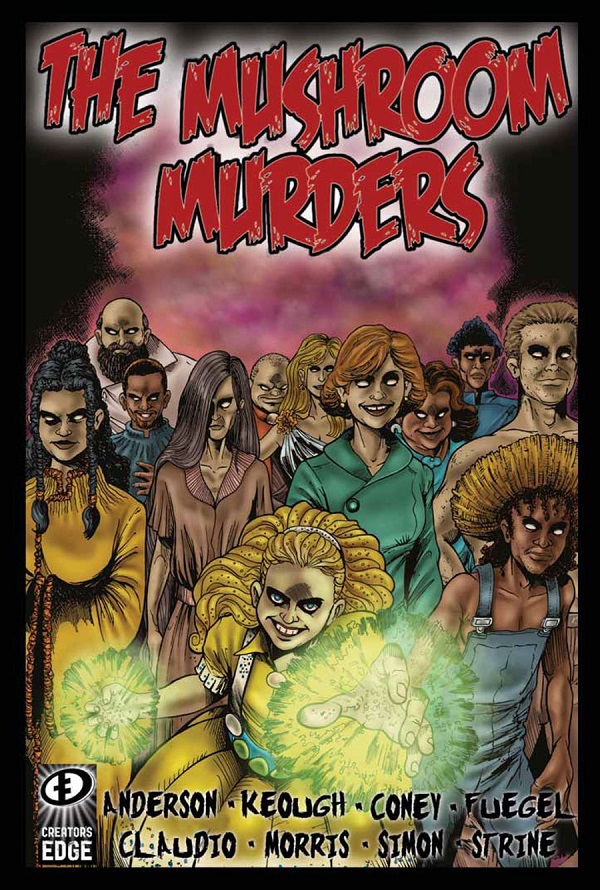Mystery done right deftly draws you into the puzzle. It gives you something to question and then leaves you just the right amount of pieces to let you think you’re solving that puzzle. In a completely natural way, a good Mystery will reveal to you the picture you’ve been developing as you collect and place those pieces. When you feel like you’ve got all of the answers and you’ve reached a happy level of catharsis, good mystery will take that picture you put together and skew it ever so slightly – like a lenticular 3D image. What you thought you knew as solid fact moves, and the entire story as a whole is richer for it. The Mushroom Murders, written by Chad Anderson and drawn by Robert Keough, is an example of indie comics mystery done right. It’s also frighteningly macabre, lightly humorous and… well, you’ll have to read it to know the rest.
I met Chad Anderson at his booth in Artist Alley during the first annual Salt Lake City Comic Con. Chad was there with his creator owned work The Mushroom Murders. He also had a few copies of his work for Marvel Comics with him for his fans. He isn’t the best known Marvel Comics writer but he is one of the Marvel writers with a vast amount of Marvel Universe knowledge. That encyclopedic knowledge of the Marvel U is part of how he got his start in the comics industry.
The idea for the book grew out of an experience I had while living in a town near Delaware City in the 90’s.
Chad was always into creative writing, but in the early 2000’s the Internet created the opportunity for that writing of his to gain a fan following. He was writing profiles on obscure Marvel characters for a website at the same time as he was producing a fan fiction on another. The fan fiction story was about a Survival style game show that would take 16 obscure Marvel villains and pit them against one another. Chad would let the readers of the fan fic vote on who they wanted to see go and week to week he would alter the storyline to match the votes. He did around 5 of those series over a period of a little more than a year. In the stories he featured characters from the Masters of Evil and the Sinister Six. That depth of knowledge required to write about characters not everyone knows about gave him a leg up when he was in contention to write on the Marvel Handbook team.
From there he submitted a few ideas to the editors but was quickly turned down. It’s good to have an in like he did because Marvel does not actively accept submissions. Even though his work was read, and appreciated, Marvel comics is the kind of publisher that seeks out talent when it wants to, and not the other way around. Chad put it best when he said:
“I wrote them, full script, and I even hired some artists to draw about 10 pages to give the submissions a little more oomph. I sent them in to some Marvel editors and they basically said, “You just haven’t proved yourself in the industry for long enough. Work on your own stuff and then we’ll see.” It was very much a “don’t come to us, we’ll come to you” kind of a feeling I got from them.”
Chad continued to hone his skill and when Marvel needed a pinch hitter he was ready. He wrote an issue staring the Runaways and the Young Avengers during secret invasion, a Spidey book during A Brand New Day, and many other one shot issues to fill in during Marvel events. He still works on Handbooks but recently focused in with laser precision on his own work. That “proving of himself” he was told to do became a passion for his own stories. He has art ready on other books and several comic scripts waiting in the dugout.
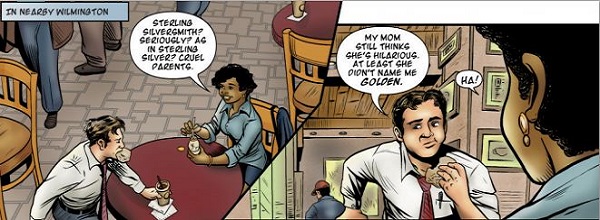
When I sat down with Chad at his home in the Salt Lake Valley, he was gracious enough to answer several questions for me. He put his two boys to bed, we opened a bottle of wine, and we talked about The Mushroom Murders. The first question I had for him was one that immediately came to mind knowing the amount of his own work he had had finished and was waiting to be published.
Mark Avo: With all of the work you’ve done, considering the time you’ve put into it with writing, not to mention the production etc, why did you choose to publish the Mushroom Murders first?
Chad Anderson: The Mushroom Murders was the best one. There are others but they didn’t turn out quite like I like. There was one other book with art that’s totally done, and fantastic, but circumstances for that book just didn’t line themselves up. This one was the most fully formed and I got it printed up myself. It’s the one I’m the most proud of.
MA: It’s long for being the one you chose.
CA: It is 5 issues, 28 pages each issue. So, it’s 140 pages plus the extras at the back.
MA: It sounds like it’s a labor of love for you and the other creators then?
CA: Yes, definitely.
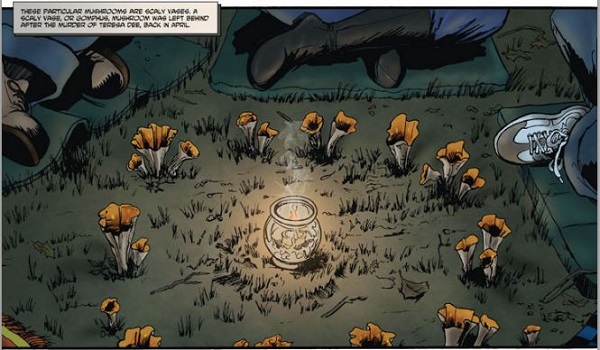
MA: Why make it so long? Wouldn’t it have been easier to tell a shorter story?
CA: That’s true, but it’s as long as it needed to be for the story. The first issue is the crazy introduction that sucks you in, the second is the slow boil, the third is the big heat up, four is the big pentultimate answers all of your questions and five is the big explosive issue that surprises everybody.
MA: You did a ton of research for the book, and you say as much in the interview you’ve included in the back of the book. Did the story grow out of reading up on Mushrooms or did the story come about and then you started researching mushrooms? How did you come up with the idea of murderous mushrooms inhabited by ghosts from the Civil War era?
CA: The idea for the book grew out of an experience I had while living in a town near Delaware City in the 90’s. A Hurricane passed over the East Coast while I was living there and the ground floor apartment I was living in got flooded. We were moved out of the apartment for a few days. The landlords came in and vacuumed all of the water out etc.
The day we moved back into the apartment everything had that damp smell. I went to bed that night, and in the morning hundreds of mushrooms had grown up out of the walls and the carpet. They were these black funguses that had stems like a dandelion when you break them off. They were really disgusting. One was coming up out of the bathroom drain and another had pushed some of the kitchen tiles up. All of those mushrooms grew up in one night because the house was full of water underneath it. It was so creepy that we got out of there the next day.
“These would make cool characters.” Like Chanterelle, that’s a great name. Then I saw “The Destroying Angel”
While I lived there though, I became fascinated by the Civil War history of Delaware City and Ft. Delaware, which is on Pea Patch Island. Both of those play hugely into the book. Obviously some of the history is made up, but Delaware City being built to be a port city to rival Philadelphia and the peach orchards, all of that stuff in the book was real.
So, years later I was sitting down and I don’t know why I was even looking but I found some really cool names of mushrooms and thought, “These would make cool characters.” Like Chanterelle, that’s a great name. Then I saw “The Destroying Angel”, which is the most poisonous mushroom. All of these names kept cropping up and I got this idea of twelve killers – one a month – and each has an appetite. Those were my character designs and that’s when I went back and did more in depth research for the history of the book.
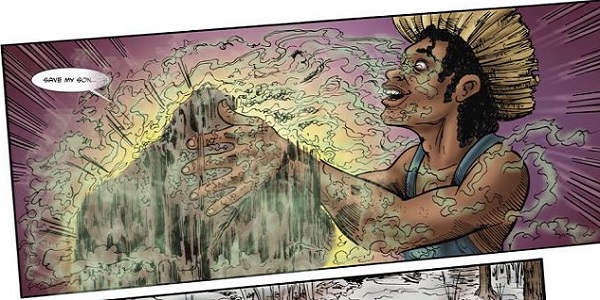
MA: The book hits its stride in chapter 2. How did your scripts evolve as you and Robert work with one another? Did that speed up or slow down the process?
CA: Bob [Robert Keough]is amazing. He never sent in a single edit to me. He never asked, can we do this a different way or change this? He just worked from my scripts and every panel that he turned in was incredible. There was never a time I asked him to change an angle or a facial expression, he just packed a punch in every panel, every page, that he turned in. So, he wasn’t involved in the writing at all but he is a huge piece of this book and why it turned out so well. You can see his original character sketches in the back. I tried out a bunch of different artists on this book and the second I got his sketches back I knew I had found the guy.
MA: Is there anything in the book, any particular page or panels that just totally floored you when Bob turned them into you?
CA: My two favorite panels, as far as being surprised by Bob, is Lucious Tucker the Police Detective and Abigail Brass. With my characters, I try to make them atypical. Everyone is used to the big strong jerk of a Police boss instead of a mild mannered, overweight and sweaty guy. When I described Lucious to Bob I described him as a Black, middle-aged and heavy set man that probably eats too many potato chips. So, my favorite panel is this one where Lucious is sitting behind his desk talking to the other detectives and Bob put a bag of potato chips on his desk and some snacks on a nearby table. I love that Bob through that in. Those details weren’t scripted but Bob really understood the character.
The other panel that I like is the Abigail Brass character that Sterling is staying with. I described her as the type of lady that has a bunch of nick-nacks like little owls lying around. When she meets Sterling her whole living room is designed with owls and cats. And, again, that isn’t something I specifically scripted it’s just something Bob took from the character description and ran with.
The book is designed to be read again and again. There is a ton of stuff that you’ll recognize on a second read through because Bob included all kinds of fantastic detail.
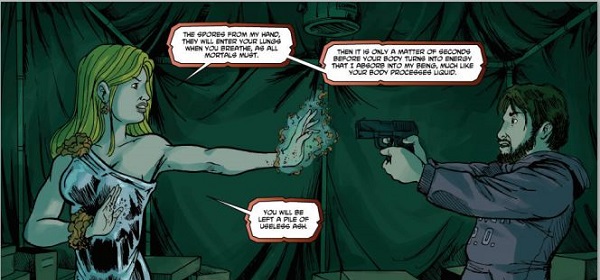
MA: Is there any kind of a sequel planned? I don’t want to possibly give anything away but the ending is crazy. I honestly didn’t see it coming and it was terrific.
CA: The ending on this is insane, and it’s meant to be. I want you thinking on every page, “Wait what?” When I designed this book, that’s how I wanted it to end. I wanted you to close it and then be haunted for days. Whenever I see a good television show or a movie, and I’m still thinking about it 3 days later, then I know it was amazing and that’s what I wanted with Mushroom Murders.
But, yeah, The Mushroom Murders was written to be what it was and that was the end. During the last few months though, I’ve had some ideas come to me and I’ve got a sequel planned and outlined but I’m not writing it yet. When I do the sequel, it’ll start with Lucious – the fat police detective – and Jeanette Lang – the FBI agent. That’s where the next book would pick up, with those two unlikable characters.
With a bit of a mischievous chuckle, Chad let his last comment hang in the air. He mentioned that he would be at Stan Lee’s Comikaze the weekend after Halloween (Nov 1-3), and that his books would be available at the Creators Edge booth AA1333. If you’re reading this and are like most of us, you won’t be attending Comikaze. The god news tough, is that you can still pick up his book online here or contact Chad about getting The Mushroom Murders on the Facebook page. If you’re a Utah local, you can find The Mushroom Murders at many of the comic shops along the Wasatch Front.
